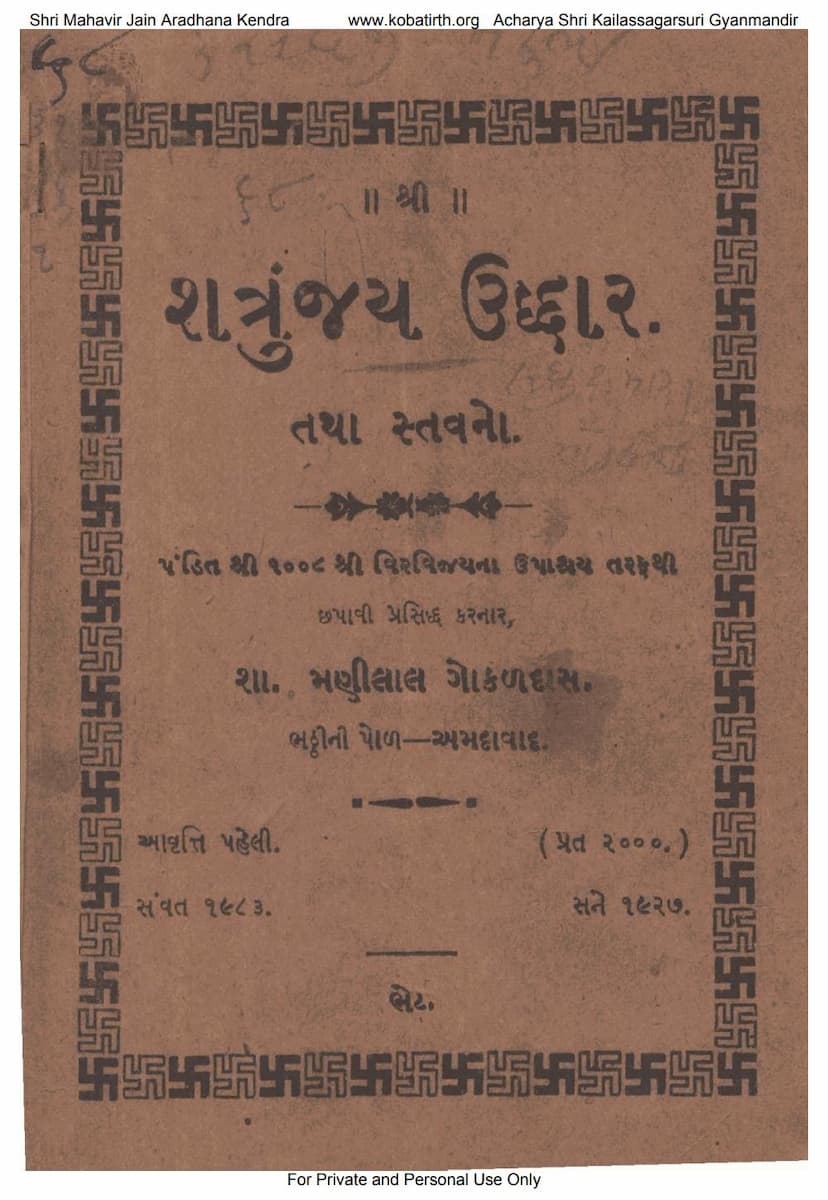Shatrunjay Uddhar Tatha Stavano
Added to library: September 2, 2025

Summary
This document is a Jain religious text titled "Shatrunjay Uddhar Tatha Stavano" (શત્રુંજય ઉદ્ધાર તથા સ્તવના), authored by Pandit Shri 1008 Shri Virvijayaji and published by Shah Manilal Gokaldas in Ahmedabad in 1927 (Samvat 1983). It is a compilation of devotional songs (stanzas or stavan) and descriptions related to the holy pilgrimage site of Shatrunjay, a mountain revered in Jainism.
Here's a breakdown of its content based on the provided pages:
Introduction and Publication Details (Pages 1-5):
- Title: "Shatrunjay Uddhar Tatha Stavano" (શત્રુંજય ઉદ્ધાર તથા સ્તવના).
- Author/Compiler: Pandit Shri 1008 Shri Virvijayaji (પ’ડિત શ્રી ૧૦૦૮ શ્રી વિરવિજયના ઉપાય તરફથી).
- Publisher: Shah Manilal Gokaldas (શા. મણીલાલ ગોકળદાસ) from Ahmedabad.
- Edition: First Edition (આવૃત્તિ પહેલી).
- Print Run: 2000 copies (પ્રત ૨૦૦૦).
- Publication Year: 1927 CE / Samvat 1983.
- Printing Press: Shri Kesariya Printing Press, Ahmedabad.
- Dedication: The book is published in memory of Shah Balabhai Dalpatbhai.
- Visuals: Page 5 includes an image, possibly a decorative element or a depiction related to Jainism.
Content - The Stanzas (Stavanas) and Narrative (Pages 6-29):
The core of the book consists of devotional poems and historical accounts related to Shatrunjay, presented in various metrical forms (dhal). The content highlights:
- Glory of Shatrunjay: The stanzas repeatedly praise Shatrunjay as the foremost pilgrimage site (તીર્થ), even surpassing Mount Meru in spiritual significance. It is described as a place where numerous omniscient beings (Siddhas) have attained liberation (moksha).
- Attainment of Liberation: The text emphasizes that Shatrunjay is a place where countless souls, including Rishabhdev (the first Tirthankara), his Gandharas (disciples), and many other enlightened beings, have achieved liberation. It's stated that even celestial beings and animals who worship Shatrunjay attain spiritual progress.
- Historical Context: The stanzas recount the history of Shatrunjay, including:
- Lord Rishabhdev's first visit: The text details the visit of the first Tirthankara, Rishabhdev, to Shatrunjay with his large entourage of ascetics.
- Bharat Chakravarti's renovations (Uddhar): A significant portion focuses on the renovations performed by Bharat, the son of Rishabhdev. This includes descriptions of his vast retinue, the construction of magnificent temples and idols, and the establishment of various rituals and offerings.
- Subsequent renovations by other rulers and devotees: The text chronicles numerous "Uddhars" (renovations, restorations, or re-establishments) of the Shatrunjay temples and idols by various Chakravartis (universal emperors), kings, and devoted individuals across different eras, tracing a lineage of spiritual patrons. These include prominent figures like Sagar, Ajitnath, Chandraprabhu, Shantidatta, Dasharatha, the Pandavas, Javad Shah, Vastupal and Tejpal, and various kings and merchants.
- The cyclical nature of time and the need for restoration: The narrative implies that due to the passage of time, temples and idols can fall into disrepair, necessitating these repeated "Uddhars" to preserve the sanctity of the pilgrimage site.
- Specific details about Shatrunjay:
- Mention of the Surya Kund (a sacred pond).
- The significance of the Rayan tree.
- The footprints of Lord Rishabhdev.
- The construction of numerous temples (prasad) with detailed descriptions of their architecture and adornments.
- The establishment of idols of various Tirthankaras, their parents, and other significant figures.
- The role of Yakshas and Yakshinis as protectors.
- The importance of devotion and pilgrimage: The text stresses the immense spiritual merit gained from visiting Shatrunjay, worshipping the Tirthankaras, and performing acts of devotion.
- Lists of names associated with Shatrunjay: The book includes lists of names of Tirthankaras, Gandharas, rulers, and devotees who have a connection to Shatrunjay, often detailing their contributions or spiritual achievements.
- The "Twenty-one Names" of Shatrunjay: A section (Page 20 onwards) specifically lists and explains the significance of 21 names associated with Shatrunjay, linking them to various events, individuals, and spiritual qualities.
- The "Stavan of Siddhachala": The latter part of the book contains several devotional songs dedicated to Siddhachala (another name for Shatrunjay), including verses praising Lord Rishabhdev, the Pandavas, and other key figures. It also includes a stanza dedicated to Chakreshwari Mata, a guardian deity.
- The final section (Page 29-30) provides a concluding prayer/blessing and offers other religious books for sale.
Overall Purpose:
"Shatrunjay Uddhar Tatha Stavano" serves as a devotional guide and historical record for Jain followers. It aims to:
- Instill faith and reverence for the sacred Shatrunjay pilgrimage site.
- Educate readers about its historical significance and the lineage of spiritual luminaries and patrons associated with it.
- Inspire devotional practices through the recitation of the stanzas and the contemplation of the narratives.
- Reinforce the importance of selfless service and renovation of holy places for spiritual merit.
The text is written in Gujarati and uses poetic language and traditional Jain terminology to convey its spiritual message.